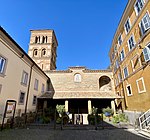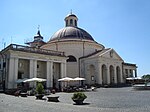Albano Cathedral
1721 establishments in Italy1721 establishments in the Papal States18th-century Roman Catholic church buildings in ItalyBuildings and structures in Albano LazialeCathedrals in Lazio ... and 5 more
Churches in the metropolitan city of RomeItaly Roman Catholic cathedral stubsMinor basilicas in LazioRoman Catholic cathedrals in ItalyRoman Catholic churches completed in 1721

Albano Cathedral (Italian: Duomo di Albano, Cattedrale di San Pancrazio) is a Roman Catholic cathedral in the city of Albano Laziale, in the province of Rome and the region of Lazio, Italy. It is the seat of the Suburbicarian Diocese of Albano.The present cathedral building was consecrated in 1721, but stands on the site of a much older basilica, dedicated to Saint John the Baptist, founded by Constantine the Great. Pope Leo III (d. 816) built a new cathedral on the site and changed the dedication to Saint Pancras, as it now is.
Excerpt from the Wikipedia article Albano Cathedral (License: CC BY-SA 3.0, Authors, Images).Albano Cathedral
Piazza Pia,
Geographical coordinates (GPS) Address External links Nearby Places Show on map
Geographical coordinates (GPS)
| Latitude | Longitude |
|---|---|
| N 41.73068 ° | E 12.65758 ° |
Address
Cattedrale di San Pancrazio
Piazza Pia
00041
Lazio, Italy
Open on Google Maps










